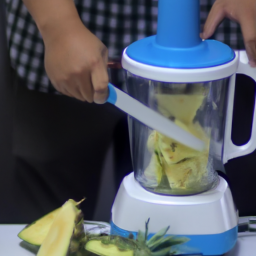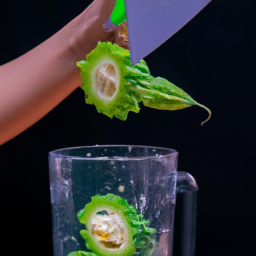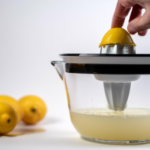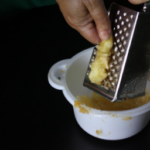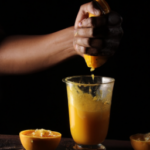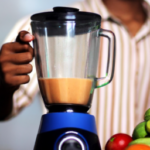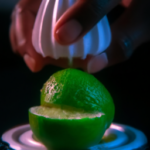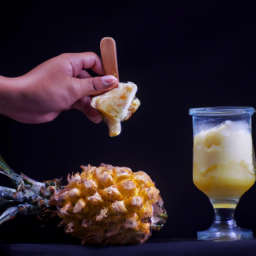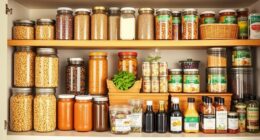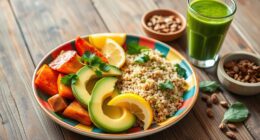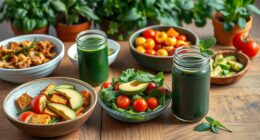Have you ever craved a refreshing glass of pineapple juice but don’t have a juicer in your kitchen? Don’t worry, I’ve got you covered!
Juicing a pineapple without a juicer may seem daunting, but it’s actually quite simple with the right tools and techniques. It’s like climbing a mountain without proper gear – it may seem impossible, but with the right knowledge and tools, you can conquer it.
In this article, I’ll guide you through the process of juicing a pineapple without a juicer. Whether you have a blender, food processor, handheld juicer, or just a strainer, I’ll show you how to extract the sweet and tangy juice from this tropical fruit.
So, let’s get started on this juicy adventure!
Key Takeaways
- A sharp knife, cutting board, blender, and strainer or cheesecloth are needed to juice a pineapple without a juicer.
- Choosing a ripe pineapple is important for juicing and the skin and core should be removed before juicing.
- High-speed blenders can break down pineapple chunks into a smooth puree quickly and straining the juice removes any remaining pulp.
- Pineapple juice can be sweetened with natural sweeteners and flavored with ginger or mint.
Gather Your Tools
You’ll need a few things to get started, so don’t forget to grab your tools! Although you won’t be using a traditional juicer to juice your pineapple, there are alternative options available.
You’ll need a sharp knife, a cutting board, a blender, and a strainer or cheesecloth. Before you begin, it’s important to take some safety precautions. Make sure your knife is sharp and your cutting board is stable.
It’s also a good idea to wash your hands and the pineapple thoroughly before you start cutting. Once you have your tools and have taken the necessary safety measures, you’re ready to move on to the next step of cutting and preparing the pineapple.
Cut and Prepare the Pineapple
As I grab my knife, the prickly exterior of the tropical fruit begs to be conquered. Choosing the perfect pineapple is the first step to juicing it without a juicer.
Look for a pineapple that has a golden-yellow color all around and smells fragrant at the base. Avoid pineapples with brown or soft spots, as these may indicate that the fruit is overripe.
Once you have chosen the perfect pineapple, it’s time to prepare it for juicing. Start by cutting off the top and bottom of the pineapple, so it can stand upright on the cutting board. Next, slice off the skin in a downward motion, following the curve of the fruit. As you cut, try to remove as little of the fruit as possible.
After removing the skin, cut the pineapple into small pieces, removing the core. Avoid common mistakes by not cutting too much of the fruit away or leaving the core in the pieces.
With the pineapple now prepared, the next step is to use a blender to make the juice.
Using a Blender
Now that the pineapple is perfectly prepped, it’s time to blend it up and create a deliciously smooth concoction that will tantalize your taste buds. If you don’t have a juicer, a blender is a great alternative.
Simply chop the pineapple into small pieces and add them to the blender. You can add a small amount of water to help with the blending process, but it’s not necessary.
There are many pineapple juice recipes out there, but I prefer to keep it simple and just blend the pineapple on its own. Once the pineapple is blended to your desired consistency, strain the mixture through a fine mesh sieve or cheesecloth to remove any remaining pulp.
And just like that, you have freshly made pineapple juice without the need for a juicer. But if you don’t have a blender, don’t worry! The next section will cover how to juice a pineapple using a food processor.
Using a Food Processor
So, I’ve tried using a blender to juice a pineapple, but sometimes it can be a hassle to clean up. That’s why I prefer using a food processor instead.
To make the juice, all you have to do is add pineapple chunks to the processor, pulse until it’s smooth, and then strain the juice to remove any leftover pulp. It’s a quick and easy way to make fresh pineapple juice without having to invest in a juicer.
Add Pineapple Chunks to Processor
Simply toss the pineapple chunks into your food processor and blend until smooth, adding a splash of water if needed to reach your desired consistency; did you know that pineapples are 85% water? This method is an easy and efficient way to make fresh pineapple juice without a juicer. Plus, you can control the sweetness and texture of the juice by adding natural sweeteners such as honey, agave nectar, or maple syrup.
If you’re looking for some pineapple juice recipes, here are three variations to try:
| Recipe | Ingredients | Directions |
|---|---|---|
| Classic Pineapple Juice | 1/2 pineapple, peeled and cored | Blend pineapple chunks in a food processor until smooth. Add a splash of water if needed to reach desired consistency. Strain through a fine-mesh sieve or cheesecloth to remove any pulp. Serve over ice. |
| Pineapple Ginger Juice | 1/2 pineapple, peeled and cored 1-inch piece of ginger, peeled |
Blend pineapple chunks and ginger in a food processor until smooth. Add a splash of water if needed to reach desired consistency. Strain through a fine-mesh sieve or cheesecloth to remove any pulp. Serve over ice. |
| Pineapple Mint Juice | 1/2 pineapple, peeled and cored A handful of fresh mint leaves |
Blend pineapple chunks and mint leaves in a food processor until smooth. Add a splash of water if needed to reach desired consistency. Strain through a fine-mesh sieve or cheesecloth to remove any pulp. Serve over ice. |
Pulse until smooth, and the pineapple juice is ready to enjoy.
Pulse Until Smooth
Blend the pineapple chunks until they’re smooth and ready to indulge in. When blending pineapples without a juicer, there are a few blending techniques to keep in mind. One technique is to blend the pineapple chunks in small batches in a food processor, which allows for better control of the blending speed and consistency.
Another technique is to use a high-speed blender, which can break down the pineapple chunks into a smooth puree in a matter of seconds. When blending the pineapple, there are also flavor variations to consider. For a sweeter juice, it’s best to use ripe pineapples, while adding a squeeze of lime juice can give the juice a tangy kick.
Adding a hint of ginger or mint can also elevate the flavor profile of the juice. With these blending techniques and flavor variations, you can create a delicious pineapple juice without a juicer. Now that the pineapple chunks have been blended to perfection, the next step is to strain the juice.
Strain the Juice
Now it’s time for you to separate the smooth puree from any remaining fibrous bits, like straining spaghetti noodles from the water, leaving behind only the velvety goodness.
To do this, you’ll need a fine mesh strainer or cheesecloth. Simply pour the puree into the strainer and press down with a spoon to extract as much juice as possible. You may need to do this in batches if you’re using a large pineapple.
Aside from its delicious taste, pineapple juice also offers a variety of health benefits. It contains high levels of vitamin C, which supports a healthy immune system, and bromelain, an enzyme that may reduce inflammation and improve digestion.
Pineapple juice can also be used in a variety of recipes, from smoothies to marinades. With the pure juice separated from the fibrous bits, you’re now ready to move on to the next step of using a handheld juicer to extract even more juice from your pineapple.
Using a Handheld Juicer
First things first, grab your handheld juicer and cut your pineapple into manageable chunks. Using a handheld juicer has its benefits, especially if you don’t have a large kitchen or if you’re on a budget. Handheld juicers are also easy to clean and store, making them a convenient tool for any kitchen.
When it comes to choosing a ripe pineapple, make sure that it has a sweet smell and is slightly soft to the touch. The color of the skin doesn’t necessarily indicate its ripeness, so don’t rely on that alone.
To juice a pineapple using a handheld juicer, simply place a chunk of pineapple into the juicer and press down firmly. Twist the juicer back and forth to extract as much juice as possible. Continue this process until you have juiced all the pineapple chunks.
The juice will have some pulp, which is normal. If you prefer a smoother juice, you can strain it using a fine mesh strainer or cheesecloth.
Now, let’s move on to using a citrus juicer to extract even more juice from your pineapple.
Using a Citrus Juicer
To get the most out of your juicy pineapple, you’re gonna need a citrus juicer that works like a charm, just like a race car on a track.
Citrus juicers are designed to extract juice from citrus fruits, such as oranges, lemons, and limes. There are different types of citrus juicers, but the most common ones are manual and electric.
Manual citrus juicers are handheld and require you to apply pressure to the fruit while twisting it to extract the juice. Electric citrus juicers, on the other hand, use a motor to do the work for you, and they’re faster and more efficient than manual ones.
One of the benefits of juicing with a citrus juicer is that you can extract more juice from your pineapple than you would by hand squeezing it. Pineapples are tough fruits, and their tough exterior can make it hard to extract all the juice by hand.
A citrus juicer can help you get the most out of your pineapple, and you can enjoy the sweet and tangy taste of fresh pineapple juice. Now, if you wanna remove the pulp or fiber from your juice, you can use a strainer.
Using a Strainer
When I don’t have a juicer available, I rely on using a strainer to extract the juice from a pineapple.
To do this, I first cut the pineapple into smaller pieces, making it easier to mash with a fork. Once mashed, I strain the juice through a fine-mesh strainer.
This results in a delicious and refreshing drink.
Cut Pineapple into Smaller Pieces
Slicing up that juicy pineapple will bring a burst of excitement to your taste buds. But what if you don’t have a juicer to extract its refreshing juice? Don’t worry, there’s a simple method that you can use to get the juice out of your pineapple without any specialized equipment. All you need to do is cut the pineapple into smaller pieces before straining it through a fine mesh strainer.
To begin, slice off the top and bottom of the pineapple, then cut off the skin to reveal the yellow flesh. Cut the pineapple into smaller pieces, about 1-2 inches in size. This will make it easier to blend and extract the juice. Pineapple is a great fruit to juice as it contains bromelain, an enzyme that aids in digestion and reduces inflammation. It is also rich in vitamin C and manganese, both of which have antioxidant properties. Juicing benefits include improved digestion, increased energy, and a boost to your immune system.
Now that you have cut the pineapple into smaller pieces, it’s time to extract the juice. Place the pieces into a blender or food processor and blend until smooth. Pour the blended pineapple through a fine mesh strainer, using a spoon or spatula to press the pulp against the strainer to extract as much juice as possible. The resulting juice will be sweet, tangy, and packed with nutrients. If you want a bit more texture, you can skip the straining step and drink the juice with the pulp. Alternatively, you can mash the pineapple with a fork to extract the juice without using a blender.
Mash Pineapple with Fork
Now that we’ve cut the pineapple into smaller pieces, it’s time to start mashing it with a fork. Using a fork to juice fruits is a great alternative when you don’t have a juicer on hand. It’s also a great way to get some arm exercise in while preparing your juice.
When it comes to hand mashing versus using a machine, there are actually some benefits to doing it manually. First off, you have more control over how much juice you extract from the fruit. You can apply more or less pressure depending on how much juice you want to get out. Additionally, hand mashing can actually result in a juicier end product since the juice is less likely to become overheated and oxidized like it can with some machines.
So, grab a fork and let’s get to mashing! Now that we’ve mashed the pineapple, the next step is to strain the juice. But before we get to that, let’s take a minute to appreciate the effort we just put in. Not only did we save ourselves from having to buy a juicer, but we also got in a little workout. Plus, by hand mashing the pineapple, we’ve potentially created a tastier and healthier juice.
Moving forward, we’re going to strain the juice to remove any pulp or leftover pieces of fruit.
Strain the Juice
Let’s separate the pulp from our freshly mashed pineapple with a simple straining technique. Using a fine mesh strainer or cheesecloth, pour the mashed pineapple over the strainer and into a bowl. Use a spoon or spatula to press down on the pulp, extracting as much juice as possible.
Here are some creative serving suggestions to elevate your freshly squeezed pineapple juice:
- Add a splash of coconut water for a tropical twist
- Serve over ice with a sprig of fresh mint for a refreshing summer drink
- Mix with sparkling water and a squeeze of lime for a light and bubbly beverage
Not only does pineapple juice taste delicious, it also has many health benefits. Pineapple is high in vitamin C, which can boost the immune system and improve skin health. It also contains bromelain, a digestive enzyme that can aid in digestion and reduce inflammation in the body.
Next, we’ll explore how to mix pineapple juice with other ingredients to create unique and flavorful beverages.
Mixing Pineapple Juice with Other Ingredients
Adding some coconut water to your freshly squeezed pineapple juice can make for a delicious and hydrating beverage. Not only does it enhance the tropical flavor, but coconut water also contains electrolytes, potassium, and magnesium. These minerals are essential for maintaining fluid balance, regulating blood pressure, and supporting muscle and nerve function.
Moreover, coconut water is low in calories and sugar, making it a healthy alternative to sugary juices and soft drinks. Mixing pineapple juice with other ingredients can also open up a world of possibilities for creating refreshing and flavorful cocktails. Pineapple juice pairs well with rum, tequila, vodka, and gin, as well as with other fruit juices such as orange, lemon, and lime.
Some popular pineapple-based cocktail recipes include Piña Colada, Mai Tai, Painkiller, and Blue Hawaiian. However, it’s important to remember that alcohol can be dehydrating, so it’s advisable to drink in moderation and alternate with non-alcoholic drinks, such as coconut water or water with lemon.
When it comes to storing pineapple juice, it’s best to keep it in an airtight container in the refrigerator for up to three days. To prevent oxidation and bacterial growth, make sure to fill the container to the top, leaving no air pockets, and seal it tightly. You can also freeze pineapple juice in ice cube trays and use it later for smoothies, cocktails, or marinades. Just remember to label the container with the date and contents, so you don’t forget about it.
Storing Pineapple Juice
To keep your pineapple juice fresh and delicious for up to three days, store it in an airtight container in the fridge. Pineapple juice is a delicate liquid that can easily turn sour if left exposed to air or warm temperatures. Therefore, it’s crucial to transfer the juice into a container that can prevent air from entering, and keep it in the refrigerator where the temperature is cool and stable.
When storing pineapple juice, it’s essential to avoid using containers made of reactive materials such as aluminum or copper. These metals can react with the juice and cause it to spoil quickly. Instead, opt for glass or plastic containers that are specifically designed for food storage.
By preserving pineapple juice in the right container and in the correct environment, you can ensure that it stays fresh and tasty for a few days.
Now, let’s move on to the next section where we’ll talk about how you can enjoy your freshly made pineapple juice!
Enjoying Your Fresh Pineapple Juice!
You can savor the sweet and tangy taste of your fresh pineapple juice by pouring it into a tall glass filled with ice cubes and garnishing with a slice of lime or a sprig of mint.
But, besides being a refreshing drink, pineapple juice also brings numerous health benefits to your body. It’s rich in vitamins C and B6, making it excellent for boosting your immune system and promoting healthy skin and hair.
Apart from its vitamin content, pineapple juice also contains enzymes that help in digestion and reduce inflammation in the body. If you’re looking to switch up your juice game, why not try adding some ginger or turmeric to your pineapple juice for an extra boost of antioxidants and anti-inflammatory properties?
The possibilities for pineapple juice recipes are endless, and the health benefits make it a great addition to your daily routine. So, go ahead and enjoy your fresh pineapple juice with the knowledge that it’s not only delicious but also good for you!
Frequently Asked Questions
Can I use canned pineapple instead of fresh for juicing?
I’ve used canned pineapple for juicing before, but it’s not as fresh-tasting. Pros are that it’s convenient and available year-round. Frozen pineapple is a better option; thaw it and prepare as you would fresh.
Is it necessary to remove the core of the pineapple before juicing?
Removing the core of a pineapple before juicing is not necessary. The core contains nutrients and fibers that can enhance the health benefits of pineapple juice. Pineapple juice benefits are a reality, providing anti-inflammatory and digestive benefits.
How long does it take to juice a pineapple using a blender or food processor?
When using a blender or food processor to juice a pineapple, it typically takes me about 5-10 minutes to prepare and blend the fruit. The pros of this method include speed and convenience, while the cons include potential waste and a less smooth texture compared to hand juicing.
What other fruits or vegetables can I mix with pineapple juice to create a unique flavor?
I love experimenting with juice pairing ideas to create unique flavors. Pineapple juice is a great base for cocktails. Mix it with orange juice for a tropical twist, or add some ginger for a spicy kick.
How long can I store freshly made pineapple juice in the refrigerator before it spoils?
To maximize the shelf life of freshly made pineapple juice, store it in an airtight container in the refrigerator for up to 3-4 days. For best flavor, add a splash of lemon juice or mix with other fruits like mango or passionfruit.
Conclusion
In conclusion, juicing a pineapple without a juicer is possible and easy to do. With the right tools and techniques, you can enjoy a glass of fresh and nutritious pineapple juice anytime. It may take a bit more effort than using a juicer, but the results are worth it.
Juicing a pineapple is like peeling an onion. It can be a bit challenging at first, but once you get the hang of it, it’s a breeze. So, don’t be afraid to give it a try. Follow the steps outlined in this article, and you’ll be sipping on delicious pineapple juice in no time.
Remember to store your juice properly and experiment with adding other ingredients to enhance its flavor. Cheers to a healthier and tastier life!
Ilana has been a vegan for over 10 years. She originally made the switch for health reasons, but soon found herself becoming more and more passionate about the ethical and environmental implications of a vegan lifestyle. Ilana is the author of The Graceful Kitchen, a blog all about veganism. She loves to cook up delicious and nutritious vegan meals, and share her recipes with others who are interested in leading a cruelty-free life. Ilana is also a strong advocate for using whole foods as the foundation of a healthy diet, and believes that going vegan is one of the best ways to achieve this.
